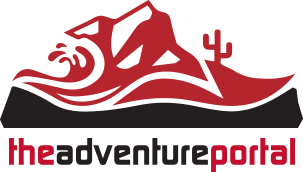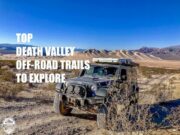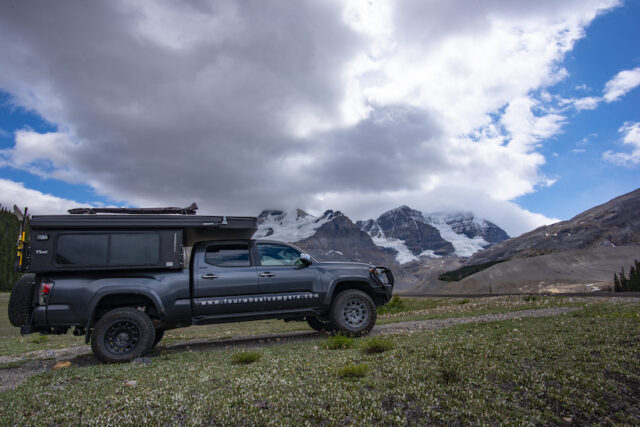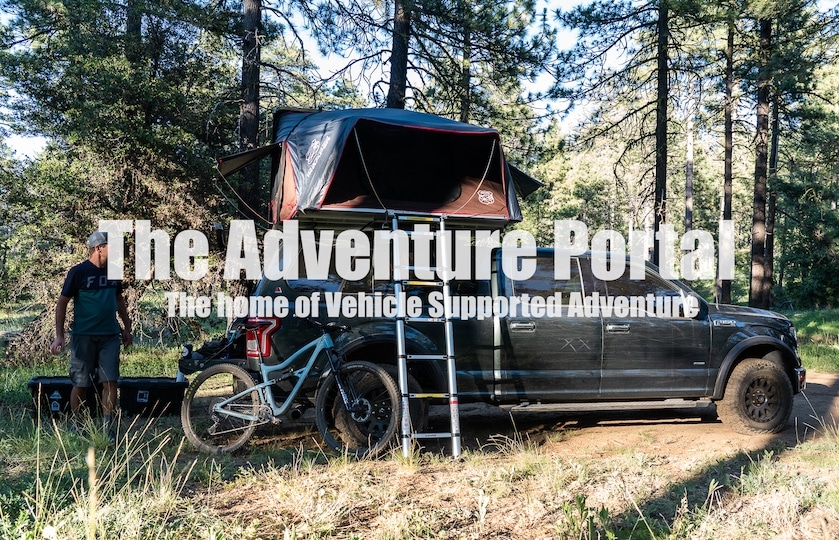“My neck is sore,” I commented.
My wife, Louise, replied, “Mine too, as she strained her neck yet again to view the magnificent mountains and glaciers outside her passenger window.” It was day three of our Canadian Rockies trip, but both of us kept stretching our necks to capture another amazing view. Undoubtably, we were in the presence of shear, natural beauty. For a minute, we paused and didn’t say a word to one another. It would be futile to convey what we saw outside our Tacoma’s windshield. We simply smiled as we marveled at successive “postcard” moments in the Canadian Rockies.
A few days prior, Louise and I had loaded our Toyota Tacoma and Four Wheel Camper in preparation to venture north from our home in Park City, Utah. It was mid-July, and temperatures were climbing. We yearned for cooler days and for adventures in the Canadian Rockies. Our packing list included hiking gear, paddleboards, and fly-fishing equipment. Oh, and bear spray! We were ready.
We crossed the Utah border at the small town of Eureka, Montana. The beauty surrounding this northern Montana town deserved further exploration, but we focused on the traveling farther north. The border crossing was relatively uneventful. The Canadian border guard was curious about the Four Wheel Camper and Toyota Tacoma and asked several high-interest questions. Minutes later, we drove north on Highway 95. The highway signs indicating kilometers. I managed my speed appropriately. Unfortunately, the all-too-common wildfire season was in full force which limited our visibly. I had driven this highway previously and boasted to Louise about the mountains and the views. Sadly, she was not able to see any of it. All she saw was smoke. We continued north and stopped briefly to top off our fuel tank in Canal Flats, British Columbia.
We drove east toward Lussier Hot Springs in Whiteswan Provincial Park. We aired down to drive the many miles of gravel/dirt roads ahead. As we gained altitude, we both began to see the sun. Just a few miles back, the sun was covered in a thick, smoke-filled sky. But now, we realized we had escaped the smoke and pollution as we climbed higher into the Canadian Rockies. The hot springs was located on the south side of the dirt road and well-marked. We grabbed our suits and quickly ventured down the banks of the Lussier River to soak. There were six to seven different pools. The temperature of the water was ideal, and we basked in the natural beauty surrounding us. Refreshed and relaxed, we continued on the road to find a beautiful, dispersed campsite. I popped open the top of the Four Wheel Camper while Louise lit the stove and prepared dinner. We finished the evening taking our dog Ruby for a walk and, later, sipping a cocktail while staring across Whiteswan Lake. At 10:30 p.m., daylight prevailed; but we needed our sleep.
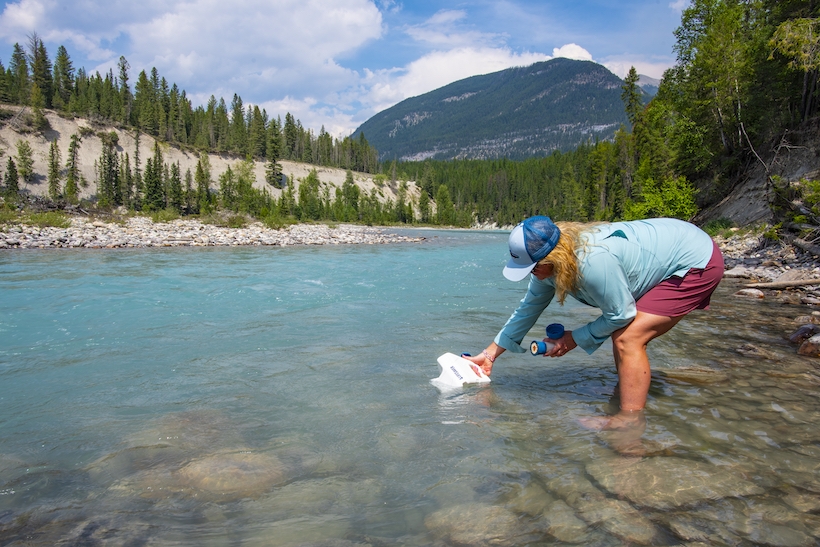
The following day found us motoring along a dirt road paralleling the Kootenay River. This massive river runs south into the US. We hadn’t seen a soul since the day before, so we were startled to see a man waving us down on motorcycle. He had lost air in his rear tire and asked if we had an air compressor. Miles from nowhere, we smiled and were happy to oblige with our EZ FLATE M.O.A.B. air compressor. In a matter of minutes, his tire was filled and he continued south. Roughly 30 miles later, we aired up and turned east on pavement to Banff, Alberta. We had intersected Highway 93 and found ourselves in the middle of Kootenay National Park. Vehicle traffic increased and our eyes scanned left and right for wildlife. The Canadian road crews mow a large and wide shoulder back from the pavement. It increases the safety for both humans and animals. We yearned to see a bear but were left with towering mountains, cascading waterfalls, and glacial-blue rivers. Yep, the drive and scenery did not disappoint! We stopped at Numa Falls to stretch our legs and view the powerful waterfall cutting through the canyon. Onward to Banff.
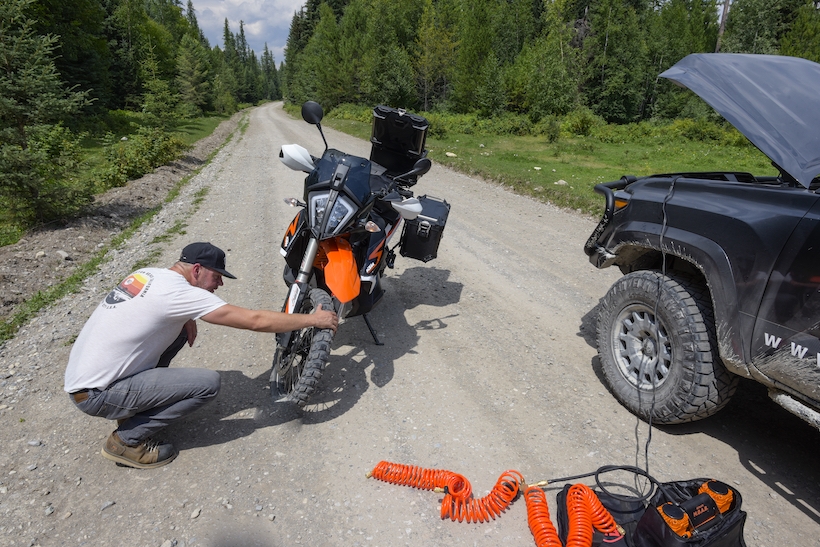
For the most part, in terms of camping, the national parks in Canada are similar to those in the United States. Camping is restricted to established campgrounds; dispersed camping is not allowed. I made camp-site reservations for this trip in late March, about four months early. I would recommend the sooner, the better. The Canadian National Park campground reservations fill up fast. Yes, some first-come, first-serve sites remain available, but we didn’t want to have the pressure or stress to find such a site each day.
Passing a few elk grazing, we pulled into the Tunnel Mountain Campground. I’m not a huge fan of campgrounds but in a national park, it is a necessary evil. After conversing with a few travelers about the Four Wheel Camper and Toyota Tacoma, we took much-needed hot showers. Many of the campgrounds offer free, hot showers—a blessing after being on the road a few days. I grabbed a few logs from the campground’s free firewood pile and started a small campfire while Louise prepared dinner. After dinner, I washed the dishes, and we both relaxed around the campfire. Once again, we noticed the light of day when we realized it was close to 11:00 p.m. We turned in for a good night’s rest.
The following morning, we made a quick stop at Banff for a few supplies but departed quickly due to the number of tourists walking the street. Banff is the epicenter of the Canadian Rockies and beckons nationalities from all over the world. Sometimes, it’s fun to see and hear the diverse crowd. However, we wanted to escape the crowds, so we traveled north on the Icefields Parkway to Bow Lake. This glacier fed lake appeared a stunning turquoise blue. We donned our backpacks and hiked around the north shore of the lake to Bow Glacier Falls. One of the unique attributes of the Canadian National Parks is that visitors are allowed to hike with a leashed dog. Our dog, Ruby, was in heaven as she bounded with us around the lake. In the distance, we glimpsed the cascading falls but were enthralled by expansive view right in front of us. We hiked to spot just below the falls and observed the glacial runoff. Silty, grayish water rushed past us on its way to Bow Lake.
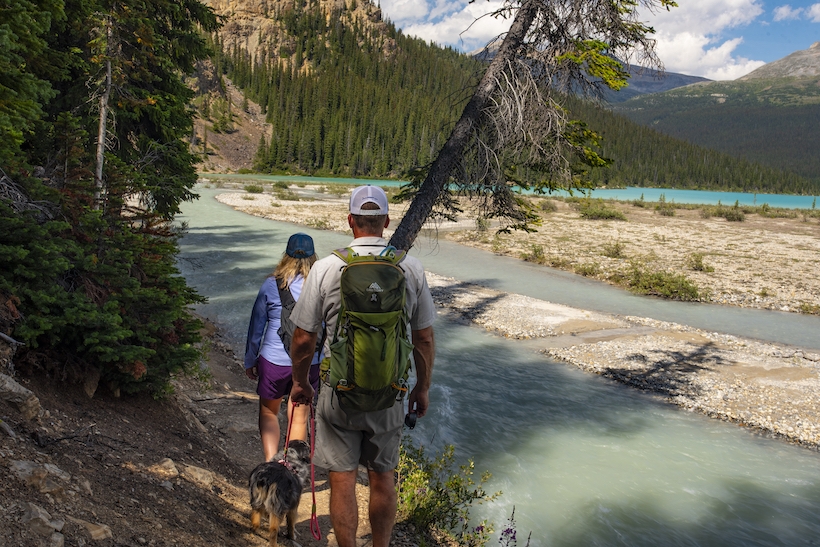
The Icefields Parkway is roughly a 130 mile north-south road that connects Banff and Jasper National Parks. Many have called it one of the most stunning drives in the world. Postcard photo-ops everywhere you look. All are magnificent! There is one gas station along the way; otherwise, it’s wild and remote country. I recommend camping halfway along the route, but we couldn’t reserve a site here and continued to Jasper National Park, at the northern end of the Icefields Parkway. We turned into our reserved campsite at Wabasso Campground. That night, the camper’s heater kicked on. Temperatures can cool, even in the summer.
Jasper, Alberta, presents a whole different feeling and flare than Banff. Sure, there are tourists but it’s more of a railroad/mountain town then a ritzy, cosmopolitan town of Banff. We walked the streets looking for a place to get a cup of coffee before heading into Jasper National Park to paddleboard Annette Lake. After we got our caffeine fix, we headed for Jasper National Park. Once again, our necks strained to see the mountains, glaciers, waterfalls, and eye-popping beauty. Towering mountains of granite rose above the Athabasca River while glacial blue lakes and rivers laid at their bases. Eye candy galore!
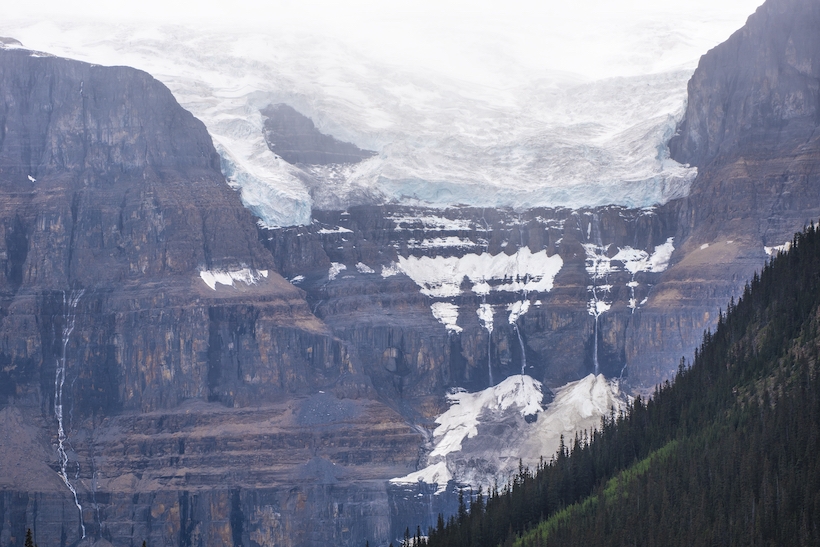
We paddled the glass-like waters of Annette Lake at the base of towering granite peaks in relative solitude. Ruby was transfixed on the fish swimming below the clear mountain lake water. With summer temperatures in the upper 70’s, it felt good to be on the water. After a few hours, we packed up and traveled back toward our campsite. With the long daylight hours during the summer months, we decided to sneak in yet another adventure.
We followed the narrow, winding road upward to the Cavell Glacier. This massive glacier hung on the rock face of the mountain and was easily spotted from the parking lot. We hiked the trail to Cavell Glacier Lake.
“Ahhh! What is that sound? Where is that sound coming from?” Louise asked.
We stood frozen on the hiking path and twisted our necks to look for where the sound originated.
“I’m not sure. Wait, look over there.” I pointed to the glacier. We noticed the glacier calving. Large segments careened down the mountainside and splashed into the glacial lake. The sounds reverberated in the horseshoe-shaped canyon. Mother Nature continued her work. Large icebergs floated in the lake that at one time were a part of the massive glacier high above. The western sun set behind the mountain and the temperature immediately dropped. We retreated back to our vehicle.
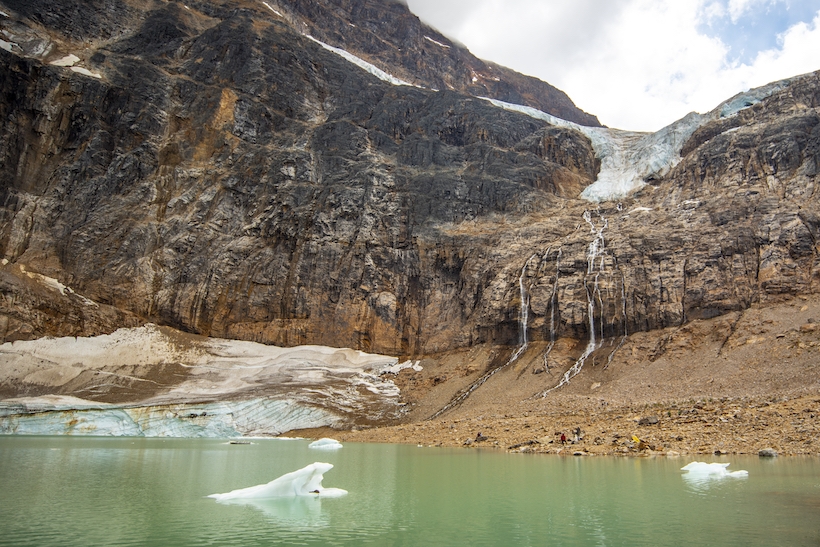
The following day found us frozen. No, not literally but the wind off the Athabasca Glacier was definitely frigid. The Icefields Parkway passes this massive glacier and beckons the adventurer to explore the foreign landscape. We parked the truck along the dirt road that at one time was covered in glacial ice. Sadly, in 1950 according to the sign, the glacier was where we had parked. Signs marked numerous points where the glacier once existed. With climate change, we felt amazed and sadden by how far the glacier receded over the years. The air off the glacier was naturally cool, so we were thankful we wore our down jackets. We hiked the base of the glacier and stopped to taste the fresh, clean water melting off it. Glacial goodness!
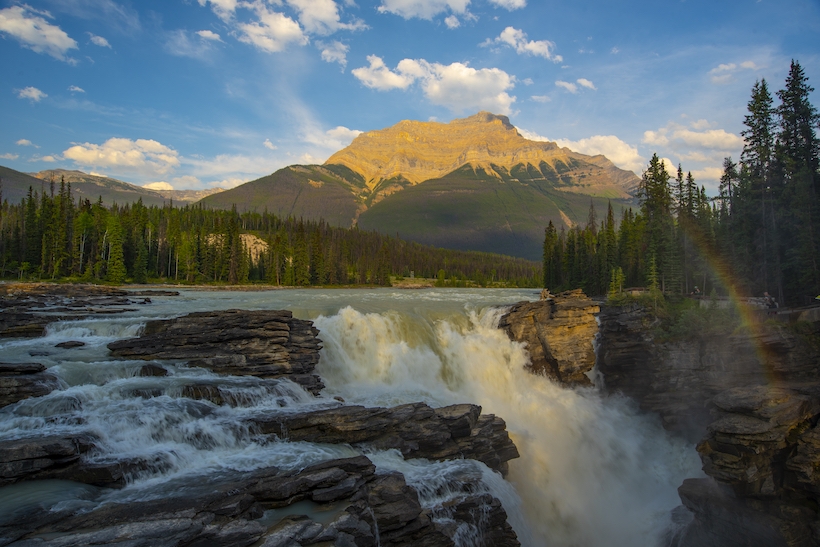
Mt. Robson marked the farthest North we would get on this adventure. A cute, little black bear winked at us as I turned the Tacoma southbound days later. Our necks were sore and grateful for not having to strain yet again as we crossed the US border. The Canadian Rockies are a vast, untouched wilderness. Lucky for us, a few roads crisscross this beautiful, postcard-worthy landscape. Roads that allow us to visit and adventure in this awe-inspiring land. Don’t hesitate. Get North and explore the Canadian Rockies.
Trip Insights:
- Obviously, the summer months present an ideal time to travel and adventure. Expect congestion.
- Obtain campground reservations as early as possible. Visit Parks Canada to get the latest information and insights.
- Go in June to see an abundance of wildlife. Go in July and August to see wildflowers and glacier blue waters.
- Purchase fuel in Alberta where it is less expensive than in British Columbia.
- Bring bug spray, sunscreen, and bear spray.
- Visit and explore Banff, Jasper, Kootenay, and Yoho National Parks
- Bring rain gear. Rain showers can appear at any time during the day.
- Bring warm layers to enjoy your adventure. There are numerous glaciers in the area.
- Buy a day pass for the number of days you will be in the parks. It will be good for admittance in all national parks. We traveled through five national parks on our adventure.
Vehicle Considerations :
- Generally, all types of vehicles can venture without issue in the Canadian Rockies.
- Many gravel roads can be driven and explored, so make sure your vehicle’s tires are in excellent shape.
- Four Wheel Camper’s, Fleet Model, is a great camper for two people. Stove, sink, refrigerator, heater, outdoor shower, and king bed make it an ideal home away from home.
